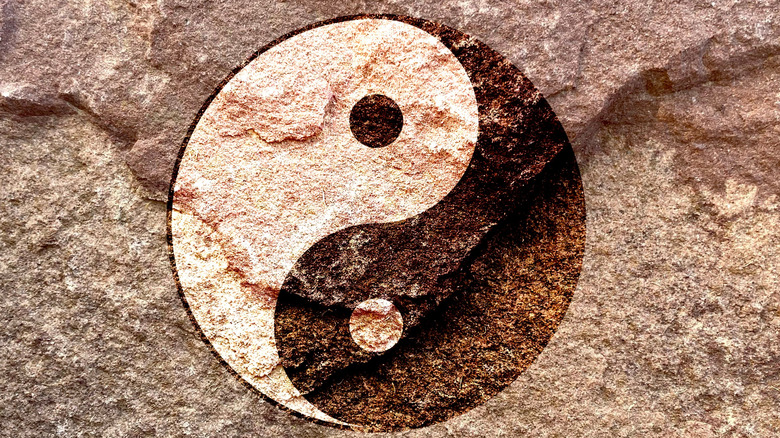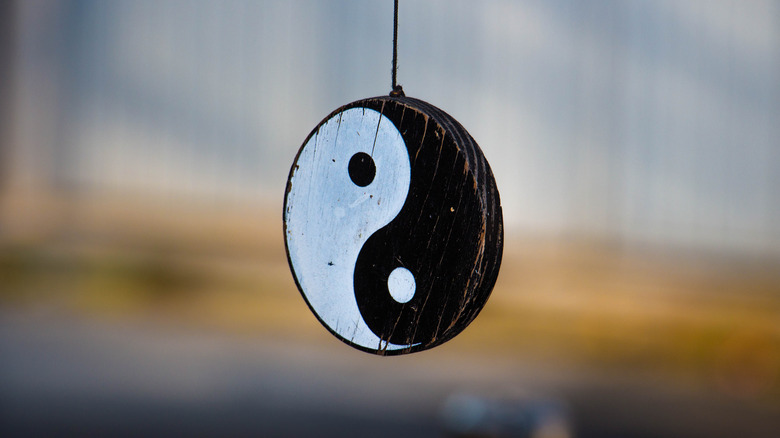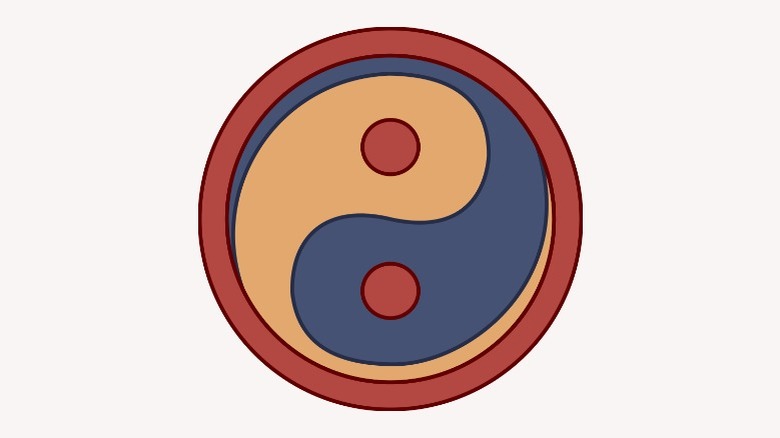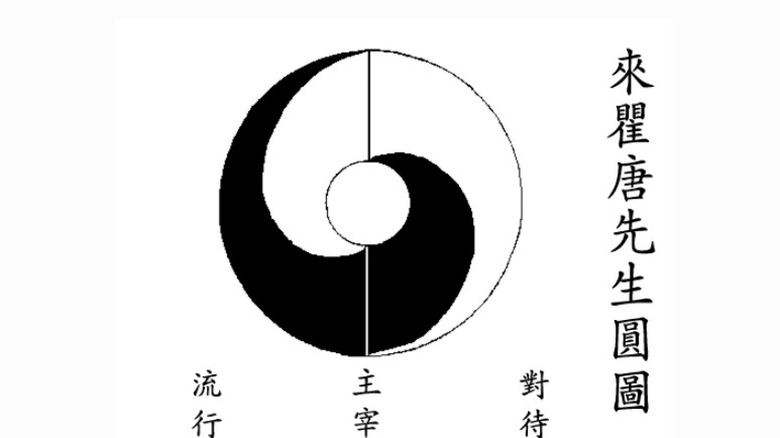Things People Get Wrong About The Yin And Yang Symbol
Symbols are much more than just a visual representation of a name, brand, or institution, as they've often become in modern society, but rather, they can carry meaning far beyond reason. Per Carl Gustav Jung, founder of analytical psychology, symbols function as archetypes. They are a visual manifestation of transcendental experience, the only possible expression of unconscious forces. They affect a person in a very specific way — one quite difficult to grasp mentally and more difficult to describe — but work on a more subtle, invisible level (via Carl Jung Depth Psychology).
The absence of this context, along with in-depth analysis of the actual material around the matter of interest, often leads to false understandings, which are much harder to eliminate than they first appear. In the era of propaganda and superficial narratives, it's easy to create meaning out of thin air. The yin and yang symbol is one of the symbols which often appears in random places, in the form of stickers, pendants, and other miscellaneous objects, completely unrelated to the intended meaning behind it. It's interesting how much appeal it has, while many people who wear it don't know much about the philosophy behind it — somehow, they are still attracted to its power. To avoid future misconceptions and with a recommendation for further research, these are things people get wrong about the yin and yang symbol.
People get the name right
While Shakespeare might disagree, calling something by a wrong name is usually a mistake. The concept is called "yin and yang," not "ying and yang," as it is commonly called in the English language, according to Paul Brians. Still, there are plenty of times when this wrong name is used. There is an American saying, "up the ying-yang," or the less common "out the ying-yang," which refers to having something in large, excessive amounts, per Merriam-Webster dictionary. In these cases, "ying-yang" essentially replaces the word "anus," in case you were wondering. Fittingly, in the past, the term ying-yang could also describe things like coitus — basically anything that people were afraid to call by its real name!
For that matter, Ying is also a popular family name for Chinese immigrants living outside of China, especially those residing in the U.S., Singapore, Taiwan, or Malaysia. This is not because people named Ying are more prone to leaving their home country, but it's a consequence of biased foreign pronunciation, so last names such as Ham, Tham, Wun, or Zhen all became Ying (via My China Roots).
But even then, the yin and yang symbol is not the correct name if one talks about the most popular visual representation of the symbol. The black and white circle with two tiny black and white dots is the sacred symbol of Taoism and it is referred as "the taijitu," but is often misused in a general or commercial way, according to Ancient-Symbols. Sometimes it's called tai chi tu, translating as tai chi symbol, but this is also a misconception — the symbol is not unique to Tai Chi philosophy or the Tai Chi Chuan martial art, explains qigong practitioner Anthony Korahais.
The symbol is about men and women
It is true that the yin and yang concept does include the masculine and feminine polarity, incorporating the concept of gender in Chinese philosophy. But the overall idea behind it is more focused on the exchange that happens between the two forces; men and women, as a very basic manifestation of these two energies, thus complement each other in this view. Confucianism and Daoism incorporated gender heavily in their traditions, but in opposing ways, almost playing out that exact interaction. Confucianism focuses on activity, which is yang, and praises characteristics commonly ascribed to men. Daoism holds in respect yin features, often embodied in women (via Internet Encyclopaedia of Philosophy).
Per Robin R. Wang from Loyola Marymount University, the concept of yin and yang also has a darker past, at least when it comes to gender. The symbol was often misinterpreted in favor of justifying "inhumane treatment" of women throughout Chinese history, and even in the present day. Wang tracked down the time when the concept transformed into an argument for female subjugation, traveling back in time to 179 – 104 B.C., when Dong Zhongshu implemented the yin and yang concept into Confucian thought — Zhongshu didn't follow its original meaning, but rather altered it serve his own ends (via "Dong Zhongshu's Transformation of 'Yin-Yang' Theory and Contesting of Gender Identity").
However, while masculinity and femininity in terms of energy can be applied to yin and yang, as, in this particular case, one represents a passive approach and the other an active one, this dual nature of the symbol can represent just any polarity that shows up in the universe, explains Mark Cartwright for World History Encyclopedia. This could mean the moon and the sun, south and north, and many others.
The black and white sides are in conflict
This is one of the most common mistakes about the concept of yin and yang, focusing on division and differences. While the symbol emphasizes duality and opposing forces, its meaning points to overcoming those differences to make them work together in union, not separately. The visual representation of the symbol implies this through its circular frame and curvy shapes that separate yin and yang, depicting a perpetual motion, with both sides always acting on and affecting the other. This way, they support each other, as one half can not be whole without the other. For that matter, the two little dots, black in the white part and white in the dark part, highlight the part where two forces meet — there is always a bit of yin in yang and vice versa.
Elizabeth Reninger for Learn Religions explains this through a simple coin metaphor — the coin is always the same coin, regardless on which side it falls. And, besides that, the coin needs both sides to, well, exist at all. According to the yin and yang philosophy, opposites don't have to cause more separation, but can instead coexist.
The symbol's meaning is agreed upon and clear
Due to its paradoxical nature, it's easy to interpret the yin and yang concept according to one's personal beliefs and perspectives of the world. So it only follows that the exact meaning for this symbol (which is generally associated with opposites and balance) is actually a bit up in the air, seeming to change depending upon specific contexts.
According to independent researcher Milorad Ivankovic (via Researchgate) it is not clear whether the yin and yang concept originates from China at all, as it can be found in the Vedas, the sacred texts found in India, too, dating back to the Iron Age, preceding the first recorded documentation of it in China by at least a thousand years. According to the Vedic texts, the symbol depicts time, specifically changing seasons and the length of day and night, and its meaning is actually astronomical. If one draws a diagram of the Earth's movement, mapping the amount of light and dark over the course of a year, the result is a yin and yang symbol which is a bit more swirled — this version can be found in several medieval Chinese texts as well.
Interestingly, NASA's all-sky map of Earth's movement in the Milky Way Galaxy from February 9, 2003, shows a strikingly similar image to the one described in Vedic texts. The image is colored in contrasting colors due to different types of radiation and it looks just like — the yin and yang symbol, you guessed it! Per Robert Nemiroff and Jerry Bonnell from USRA, unfortunately, though, the high speed that caused the radiation to look like this is still unexplained (via Astronomy Picture of the Day).
The two sides represent good and bad
The yin and yang concept is often described as the opposition between positive and negative, but the emphasis is in not just their difference, but their codependence. Because of this, no side can be seen as simply good or bad, as the other wouldn't exist without it. According to writer Guyus Seralius (via Pantheism), this could be interpreted using the law of conservation, known from physics: There is a limited amount of energy and matter in the universe, so any adjustment begets another, such that, overall, the whole is always the same. If applied to yin and yang (and specifically in light of good and bad), it means nothing can become fully negative or positive, as the sides interact with each other, always striving toward balance.
That is why, per religiologist Jonas Atlas, one should not get too devoted to either side, as this attachment is what makes one side good or bad — at least in one's mind. If a person approaches something with neutrality, it's easier to understand why both sides — yin and yang — are always needed. But that doesn't mean negative traits or acts should just be allowed because they are an unavoidable part of life. Rather, evil is attributed to a disruption of the balance of the universe, and it should be opposed, but in the right way — by understanding and restoring that balance.
The symbol is innately Chinese
Because the symbol is very old, it is not quite clear where it derives from — there's the theory that suggests the symbol existed long ago in India. But the evidence found in China shows the symbol was used there since at least the 14th century B.C., when it was carved onto oracle bones to assist with fortune-telling rituals. It is believed that the symbol represented natural events like day and night at the time (via Internet Encyclopaedia of Philosophy).
However, the symbol can be also found in a very unexpected place: among the symbols of the Roman Empire, specifically amidst nearly 300 insignias of the military units of the late Roman Empire. As stated by scholar Giovanni Monastra, several symbols identical to yin and yang diagrams were found in the Notitia Dignitatum Omnium tam Civilium quam Militarium, a directory of Roman administration functions dating back sometime between the 4th and 5th century A.D. The detailed list contains official titles, but also the insignia of every unit, many of which were metaphysical in meaning. Monastra names it "an archive of late imperial symbolism," and that is important, as the Romans hadn't lost their connection to the sacred yet as a society — they still included it in very earthly matters. One insignia shows the yin and yang symbol in reverse, moving counterclockwise and painted red and yellow, while the other portrays a deconstructed version of the symbol. No one knows how exactly the symbol got there, and there is a big gap in research about this in academic circles.
There is only one version of the symbol
Since the symbol has appeared through history in different time periods as well as locations, diverse versions of the symbol have been found. According to martial arts and meditation master Joseph Zeisky, the yin and yang diagram can be drawn in three different ways when used in Tai chi martial arts.
The first version (shown above) depicts the concepts of movement, stillness, and acceleration — the black and white half are swirled, while the center is still. The second version portrays a balanced state, and this is the symbol many people are the most familiar with — equally divided black and white halves, with two tiny dots on each side. The third diagram shows the two halves in opposition with each other — the black and white are completely divided into small arc-shaped sections, but are spread out through the circle evenly — and illustrates the concept of building and storing energy.
It's specifically tied to religious beliefs
Contrary to popular belief, the concept of yin and yang was created out of observation of the natural world and social environments, and it doesn't include any dogma or belief one needs to accept first. While the concept is used in Taoism, Confucianism, Buddhism, and even in Traditional Chinese Medicine, it is not inseparable from these belief systems. It's actually been used and written about in a number of other places.
Found on ancient bones, the symbol was included in "the earliest comprehensive dictionary of Chinese characters" composed in 100 A.D., as well as in Shijing, a Chinese Book of Songs. There was also a Yinyang school in China – existing between 770 and 481 B.C. and between 403 and 221 B.C. — devoted to research and art of yin and yang, focusing on patterns in nature, calendar science, future-telling, and astronomy. In Yijing, The Book of Changes, yin and yang represent a more concrete substance, xingzhi, and can be seen and felt with the five senses.
Zuozhuan, The Book of History describing the concept of the vital energy qi (ch'i), speaks about yin and yang as two forces that produce qi, the foundational universal energy — the whole universe evolves from yin and yang. Huangdi neijing (The Yellow Emperor's Classic of Internal Medicine) is the core medical text on which Chinese Traditional Medicine is based, and it also includes the yin and yang concept, as it focuses on the vital energy of qi, using it to divide organs and bodily functions by whether they are yin or yang (via Internet Encyclopaedia of Philosophy).
The concept is easy to grasp for anyone
The concept of yin and yang is the diametric opposite of typical Western views. While the first presents a circular way of seeing things, in which everything relates to one another and is constantly changing, Western society tends to promote a linear way of thinking, one which is the long-term result of history and culture. As explained by business professors Christiane Prange and Alicia Hennig, Western thought processes highlight exclusion and othering, strategic planning, and simplicity. Eastern ideas — and this could be applied to the yin and yang concept as well — focus on a balance of opposites, acceptance of constant change, and the paradoxical nature of existence.
Professor of Ethics Michael Slote from the University of Miami (via Taylor&Francis Online) discusses the difference between how the East and West perceive reason and emotion: another case of yin and yang polarity. While the West believes it is possible to detach thinking and feeling, the East doesn't. A clear example of that? The Chinese word "xin ” is translatable as "heart-mind," denoting the idea that heart and mind are inseparable, just like yin and yang.
Things are always either yin or yang
Because the two polarities exist only in relation to each other, neither of them is absolute. Think about comparing two shades of gray: One will be darker than the other, but that still wouldn't make either of them black or white. That's the ultimate idea behind the yin and yang concept — relativity. As such, the values on each side can never be definitive and final, explains John Bellaimey, Chaplain and religiologist.
One thing can be yin on one occasion but yang on another occasion. Bellaimey gives some examples, saying that a plant that is growing is yang, but when it's harvested it becomes yin. This is why it's confusing to try and define what is yin and what is yang, because the nature of things and people constantly switch; it's all just a matter of context and circumstance. Everything in the universe is in constant change — this is the core philosophy behind yin and yang — so an object that is yin can become yang, and vice versa (via TedEd).
It is a satanic symbol
Christianity often portrays things according to its own understanding of good and evil, and the yin and yang symbol is no exception. Kenneth Copeland Ministers' Church from Texas identifies the majority of Asian philosophies as nontheistic, meaning they don't highlight the role of god. This is not in line with religions like Christianity, which divide the world strictly into good and evil, looking to eliminate everything that does not fit the dogmatic definition of "good." But the yin and yang concept teaches that polarities should be understood and accepted, as they are inseparable anyway; according to the writer, this negates the existence of god and should be avoided, as it promotes "godless philosophy of life."
These types of parochial views on theology and philosophy led to numerous false doctrines still firmly present in some contemporary societies. Some groups actually go as far as calling the yin and yang symbol satanic, rejecting the whole philosophical concept behind it as untrue and false (via Jesus is Saviour), emphasizing the alleged Satanic doctrine behind it (as well as behind many other Chinese schools of thought). It's an interpretation that seems to demonstrate a poor understanding of the nuanced philosophy behind other belief systems, and that's just to say the least.











